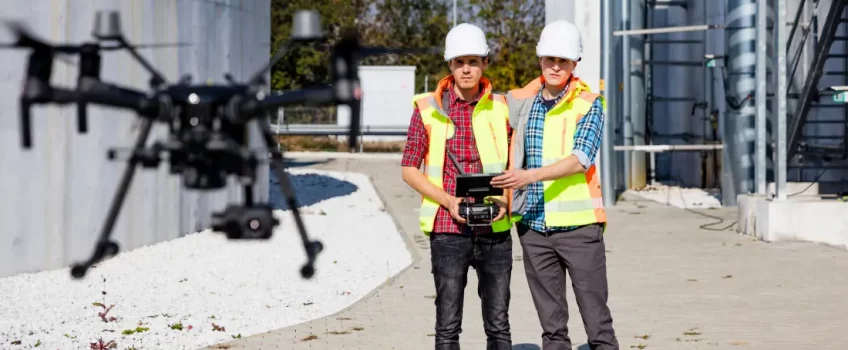
It’s a little surprising that drones in manufacturing are not as widely used since the global drone market is expected to exceed $15 billion in 2022. Right now, drones in manufacturing account for less than 2% cent of the total drone deployment despite the countless benefits unmanned aerial vehicles (UAVs) present to several industries. In this post, we take a closer look at how drones can be used in manufacturing along with some of the regulations.
Where Are Drones Mostly Used?
Currently, industrial applications of drones are predominantly outdoors with applications in agriculture, energy, logistics, mining, construction and infrastructure. As stated by Goldman Sachs, 2016; Mazur and Wiśniewski, 2016, these sectors benefit from a drone’s ability to fly quickly and safely at high altitudes. it helps them reach places that are difficult, hazardous or expensive to get to otherwise. Drones in manufacturing, on the other hand, are almost exclusively used indoors.
The State Of Drones In Manufacturing And Elsewhere
Despite the fact that the industrial use of drones is growing, there are currently few applications in manufacturing. There are some interesting current and potential applications of drones in manufacturing, particularly those that help manufacturers “see” and “sense” data inside their facilities.
While plenty of research exists on the technical capabilities of drones, such as robotics, control and computer vision, there is limited data on the practical applications of drones in manufacturing. There is currently a gap in the technology of drones and their lucrative applications in manufacturing. This is largely due to the novelty of the technology and that drone development for manufacturing took a back seat.
Over the last 10 years, the capabilities and technologies behind drone technology have improved significantly while prices have plummeted. This has resulted in greater availability for a wider range of businesses with many manufacturers considering the potential benefits of drones in manufacturing.
Benefits Of Using Drones In Manufacturing
Drones are not simply fun gadgets to play with but rather sophisticated pieces of technology that can collect and record data humans can’t. One of the best-known applications of drones (and robots) is to access hazardous environments or hard-to-reach places. From there, they can send information to a human operator for analysis all without putting anyone in danger.
While a lot of focus has been on drones in transportation, such as last-mile delivery, there are other beneficial applications.
Avoid Equipment Failure And Increase Compliance
Drones may help with asset monitoring by using infrared and thermal sensors to acquire precise temperature readings on equipment. Drones would notify operators in time to address temperature issues before they result in equipment failure, allowing them to avoid unforeseen downtime. By using drones in manufacturing, companies can increase compliance by recording temperature checks, observing production lines and identifying potential faults from the drone images.
Drones In Manufacturing Can Save Time And Money
Using drones in manufacturing can help business owners save time on inventory checks which is usually a lengthy process. Drones can carry out more accurate and faster inventory checks compared to workers scanning RFID chips or barcodes. This means manufacturers can free up valuable time and allocate resources to production instead.
Improved Health And Safety
Drones in manufacturing can also improve health and safety compliance since most maintenance inspections require production to cease for safety considerations. This would not be the case if a manufacturer uses a drone to inspect the machinery as production could continue without compromising worker safety.
Drones Can Speed Up The Production Line
As anyone in manufacturing might know, moving certain parts or components between different areas of a facility can be time-consuming. However, smaller drones can transport parts up to 11 lbs (5 kg) while larger drones have a payload capacity of 500 lb (227 kg). They can quickly fly between the warehouse and production centre to collect and deliver much faster than a person.
Recommended: How Much Weight Can A Drone Carry?
Improved Delivery Times
Using drones in manufacturing to transport parts, even short distances, or for picking and packing can save valuable time. At the same time, drones can be programmed to fly over buildings and crossings, identifying obstacles that could slow down a delivery driver. Drones can record these obstacles in real-time which will help operators create pre-programmed and alternative routes, allowing for a more efficient delivery system.
Guidelines For Using Drones
Although drone technology is used in many sectors, some challenges have slowed down the adoption of drones in manufacturing, including a lack of consistent and clear regulation. However, this was addressed in 2021 with new EU guidelines on leisure and commercial drone operation. These were established to regulate the manufacturing and operation of drones using a risk-based approach categorised into low, medium and high.
The restriction on ‘beyond visual line of sight activities’ has been lifted for drones weighing more than five kilograms. This enables bigger drones, which are particularly suited to commercial and industrial applications, to be utilised more consistently in manufacturing, although you still need permission. For more information on drone regulations and where you can fly a drone, visit the Civil Aviation Authority website.
Drones In Manufacturing: Summary
Currently, drones are mostly used in entertainment, photography and real estate. Industrial drone use comes in at approximately 25% of which manufacturing accounts for around 2% (Source: Raconteur).
The biggest obstacle, apart from certification and regulations, is that certain factories, facilities and assembly plants may be too complex or hazardous for drones. Whether it’s automated machines or welding robots, some may cause interference with drone communications.
Despite the challenges, drones have already proven to be exceptionally helpful and certainly a potential solution more manufacturers may consider in the future. While certainly promising, some issues such as battery life and payload capacity need to be ironed out before we see more drones in manufacturing.
For more information on engineering, manufacturing and technology, please follow our blog. You can also join the conversation on social media using the hashtag #PRVtech.


 Mail:
Mail: 



